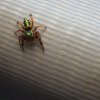AmphibianAddict
Arachnopeon
- Joined
- Aug 30, 2018
- Messages
- 45
Hi!! Now, before you say that this should be posted in the classifieds... I don’t know exactly what species I want just yet, so I didn’t think it belonged there; please correct me if I’m wrong! Okay, so, while most people in the invert community like their tarantulas, centipedes, and scorpions, I like my jumpers!! Tarantulas and centipedes kind of creep me out and I just don’t have that much experience with scorpions. So, I got into jumping spiders! I have two species right now, a salticus scenicus and a phidippus audax. The only other species I could find are phidippus regius and they look to much like my audax for me to get one. So, I was wondering if someone could get to any more colorful or personable species, I thought some peacock jumpers would be SUPER cool, but I doubt I could get to one (because of Australia’s stupid import laws). I’ve seen this little white spider online, but I can’t find the species name. So overall I can’t find very many species of this VERY underrated spider.







